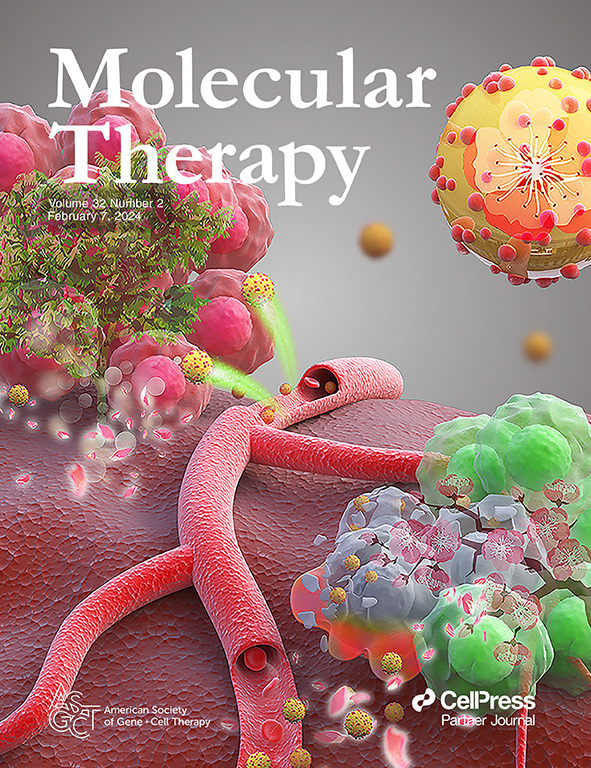Nonclinical evaluation of renizgamglogene autogedtemcel for SCD and TDT.
IF 12
1区 医学
Q1 BIOTECHNOLOGY & APPLIED MICROBIOLOGY
引用次数: 0
Abstract
Sickle cell disease and transfusion-dependent β-thalassemia can be treated by fetal hemoglobin upregulation. Disruption of the distal BCL11A binding site at the HBG1/2 promoters to induce fetal hemoglobin using either SpCas9 or AsCas12a mimics multiple hereditary persistence of fetal hemoglobin mutations. AsCas12a showed higher editing efficiency, higher specificity, and increased fetal hemoglobin induction potential compared with SpCas9. AsCas12a-edited healthy donor CD34+ cells exhibited long-term, multi-lineage, and polyclonal engraftment in immunocompromised mice. High-level fetal hemoglobin induction was observed in erythroid progeny derived in vivo from edited healthy donor CD34+ cells, and sickle cell disease or transfusion-dependent β-thalassemia donor CD34+ cells in vitro. In erythroid cells from patients with sickle cell disease, gene editing reduced sickling and improved rheological behaviors under deoxygenated conditions. In erythroid cells from patients with β-thalassemia, gene editing ameliorated ineffective erythropoiesis and significantly increased hemoglobin content per cell. A comprehensive off-target editing evaluation in edited CD34+ cells showed AsCas12a to be highly specific, with no off-target editing detected. In summary, editing CD34+ cells at the HBG1/2 promoter distal BCL11A binding site using AsCas12a phenocopied hereditary persistence of fetal hemoglobin mutations, demonstrating its potential as a gene editing approach for the treatment of β-hemoglobinopathies.renizgamglogene自体细胞治疗SCD和TDT的非临床评价。
镰状细胞病和输血依赖性β-地中海贫血可通过上调胎儿血红蛋白治疗。使用SpCas9或AsCas12a破坏HBG1/2启动子的远端BCL11A结合位点以诱导胎儿血红蛋白,可以模拟胎儿血红蛋白突变的多重遗传持久性。与SpCas9相比,AsCas12a显示出更高的编辑效率、更高的特异性和更高的胎儿血红蛋白诱导潜能。ascas12a编辑的健康供体CD34+细胞在免疫功能低下的小鼠中表现出长期、多系和多克隆植入。在体内从编辑过的健康供体CD34+细胞衍生的红系后代中观察到高水平的胎儿血红蛋白诱导,并在体外观察到镰状细胞病或输血依赖性β-地中海贫血供体CD34+细胞。在镰状细胞病患者的红细胞中,基因编辑减少了镰状细胞,并改善了缺氧条件下的流变学行为。在β-地中海贫血患者的红细胞中,基因编辑改善了无效的红细胞生成,并显著增加了每个细胞的血红蛋白含量。对编辑过的CD34+细胞进行的全面脱靶编辑评估显示,AsCas12a具有高度特异性,未检测到脱靶编辑。综上所述,利用AsCas12a编辑HBG1/2启动子远端BCL11A结合位点的CD34+细胞可以表型地复制胎儿血红蛋白突变的遗传持久性,证明了其作为治疗β-血红蛋白病的基因编辑方法的潜力。
本文章由计算机程序翻译,如有差异,请以英文原文为准。
求助全文
约1分钟内获得全文
求助全文
来源期刊

Molecular Therapy
医学-生物工程与应用微生物
CiteScore
19.20
自引率
3.20%
发文量
357
审稿时长
3 months
期刊介绍:
Molecular Therapy is the leading journal for research in gene transfer, vector development, stem cell manipulation, and therapeutic interventions. It covers a broad spectrum of topics including genetic and acquired disease correction, vaccine development, pre-clinical validation, safety/efficacy studies, and clinical trials. With a focus on advancing genetics, medicine, and biotechnology, Molecular Therapy publishes peer-reviewed research, reviews, and commentaries to showcase the latest advancements in the field. With an impressive impact factor of 12.4 in 2022, it continues to attract top-tier contributions.
 求助内容:
求助内容: 应助结果提醒方式:
应助结果提醒方式:


